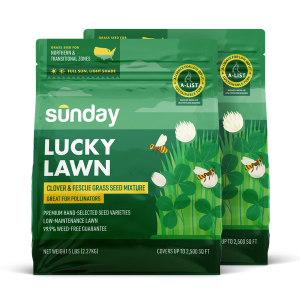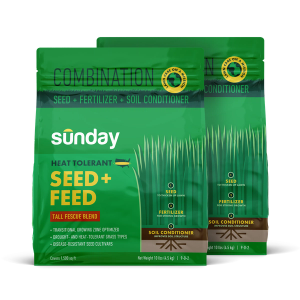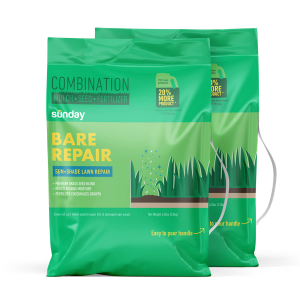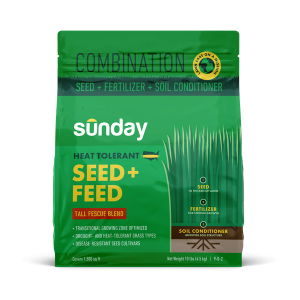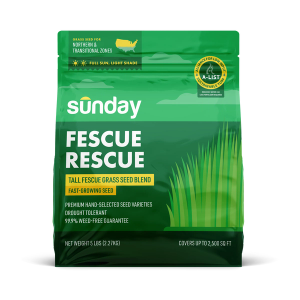Sustainability isn't about buying all the right products. It's about using less and growing smarter. It’s about letting your little ecosystem do its thing, with a little extra support from you.
Here are five ways to make your yard more sustainable, and extra help from Sunday products if you need it.
1. Use less water
Automatic sprinklers on short, daily timers make for lazy, shallow-rooted lawns. The grass learns to wait for its daily sip, so it never bothers to dig deep. Here's how to get a lawn that's efficient, not just thirsty.
You get there by watering deeply and infrequently. That just means you water for longer with more time between waterings. This lets the soil actually absorb the water.
If you have to advanced your watering saving habitats, add Drought Defense to your routine. It’s not just fertilizer. It’s made with advanced surfactant technology for your dirt. This helps water penetrate deep into the soil and get to the roots, instead of just running off. Meaning, the water you do use actually sinks in and works harder, so you can water less.
Sunday Tip:
Water in the morning and let your grass tell you when it's thirsty. It'll look a little dull (that's your cue, not a crisis). And stop watering on the schedule you set last year. Adjust your watering every season.
2. Make it pollinator-friendly
Growing just grass can get kind of boring (yeah, we said it) and isn’t great for the ecosystem. Biodiversity is the goal. A yard with a variety of plants is stronger and, frankly, way more interesting.
Our top tip? Tolerate the clover. If you’re trying to be more sustainable, decide which weeds you're willing to let in (hint, hint, they aren't all so bad).
If you're ready to really lean in, our Lucky Lawn Grass Seed is your answer. It’s a mix of premium, drought-tolerant fescue and resilient microclover. The fescue is bred to stay green with less water, while the microclover is a super-tough groundcover that fills in thin spots and feeds your soil. It’s a self-sufficient lawn in a bag.
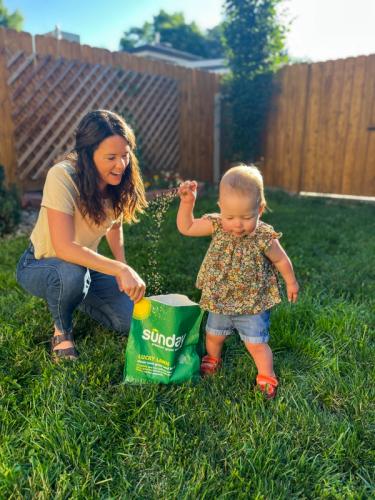
Sunday Tip:
Clover is a free nitrogen factory. It literally pulls fertilizer out of the air and feeds your soil. Plus, it helps bees and pollinators. Win-win.
3. Build a lawn that doesn't quit in August
To grow a more sustainable lawn, the goal must be resilience, not perfection. You want a lawn that doesn't quit on you during the peak heat of summer, but isn't the greenest lawn on the block either. The key to achieving this is to feed the soil, not just the plant. The secret to stress-tolerance isn't just nitrogen—it's strong soil health.
This is why we're so into your yard data. We soil test so we can build you a Custom Lawn Plan with resilience-builders like potassium (think: electrolytes for your grass) and seaweed extract that help grass build stronger cell walls and handle heat and stress. You're not just greening your lawn. You're training it for summer.
Sunday Tip:
Mow high. Think: taller grass grows deeper roots. And deeper roots make for a tougher lawn. It’s spring training for your lawn's 'survive the heat' season.
4. Rethink what "good" looks like
Did you ever think: You might not even need all that grass? This is the "anti-golf course", "rewilding" your lawn part. We’re talking about strategically shrinking your lawn.
Turn that high-maintenance patch of grass in the side yard into a low-maintenance garden bed. Or maybe consider planting a native pocket prairie or a vegetable patch.
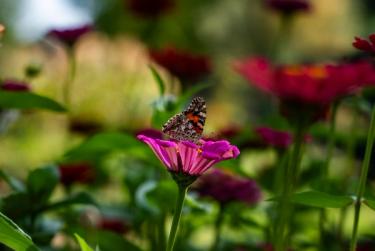
For the parts of your yard that aren't grass, there's our WonderFert Flower Garden Fertilizer. It’s not just any plant food. It’s a liquid nutrient pack designed to feed your soil microbes and your plants. You get more flowers and tastier veggies because you're building a healthier garden from the ground up, not just forcing short-term growth.
Sunday Tip:
The goal: less mowing, more growing. A diverse yard landscape is way more interesting (and sustainable) than 5,000 square feet of grass.
5. Stop buying solutions to problems you don't have
This might be the most important one. Sustainability is often about what you don't do. Old-school yard care is built on selling you stuff you don't need, "just in case."
So stop guessing. This means rethinking products like "Weed & Feed." It's a one-size-fits-all combo that applies herbicides with fertilizer, which... when you think about it, doesn't make a lot of sense. Why apply weed killer everywhere? And stop over-fertilizing. There really is too much of a good thing.
This is the whole point of the Sunday Soil Test. It’s a simple 15-minute test that tells us exactly what your soil is missing (and what it already has plenty of). It’s the tool that lets you stop guessing, and it's what allows us to build your Custom Lawn Plan in the first place. It's the antidote to overconsumption. Minimalism, here we come.

Sunday Tip:
Knowing your soil's phosphorus level (which we get from your test) keeps you from buying fertilizer with added P that just runs off and feeds algae in the nearest lake.
Your yard's already working hard
Sustainability isn't about doing everything perfectly. It's about picking one or two things and showing up. You don't have to overthink it. Your yard's already working hard. You're just helping it along.
So pick one and try it. See what happens. Your yard (and your Saturday mornings) will thank you.







